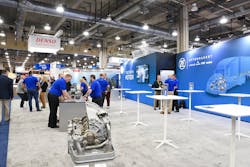Trucking is an industry in transition, and “partnership is the new leadership,” explained Jonathan Randall, Mack Trucks North America president, recalling pre-pandemic discussions with company executives—and nothing has changed since. Indeed, the pace of change has accelerated as new partnerships and technologies are developed.
“The transparency and the collaboration required to get us through the last four years is going to be even more important for the next decade and beyond, as the commercial vehicle industry changes at a pace that we haven’t seen,” Randall said, opening the Heavy Duty Aftermarket Dialogue presentations here ahead of HDAW. “The importance of our relationships with our suppliers will continue to grow—again, the transparency, collaboration, inclusiveness—in driving performance in the future.”
Randall noted that Volvo Group, Mack’s parent company, has invested an “unprecedented” $2 billion in its North American operations. And it’s not all going toward e-mobility and alternative fuel systems.
“Diesel is going to be here for a long while, as far as we’re concerned,” he said. “Obviously, we’re making the investments to continue to meet the industry requirements.”
Heavy-duty outlook
Of course, an audience of parts suppliers and distributors needs to know what to expect from truck manufacturers in the coming years, so Randall provided a market update. North American heavy-duty truck production came in slightly above projections for 2023, finishing the year at 330,849 units, while the industry built 109,500 medium-duty units, also slightly above forecasts.
For 2024, the forecast calls for 290,000 heavy-duty trucks and 115,000 medium-duty trucks to be produced. Randall noted that a “big chunk” of the big-truck reduction would come from the long-haul segment after over-the-road fleets purchased new tractors at a high rate during the market boom.
On the other hand, he suggested that straight trucks likely will see their share of the Class 8 market grow in 2024, rising from 12% to 15-16%.
Day cabs, likewise, will continue to outperform historical norms, projected to come in at about 28% of the market.
“Pickup-and-delivery, hub-and-spoke businesses are still doing very well,” Randall said. “Our straight-truck order board is incredibly strong.”
Randall also noted that Mack dealers typically carry as much of a third of their inventory in stock trucks—but that changed during the market run-up.
“On the heavy-duty side, we haven’t had a truck on a dealer lot in the last three years without a customer name on it,” he said. “Our orders now, 94% are coming in with customer names on them—we’re normally at 65 to 70%—so the market this year still remains incredibly robust, at least for Mack and in our core markets.”
Read more: Volvo Group to increase North American heavy truck production capacity
While the Class 8 market was down somewhat from peak levels, the medium-duty segment continues to grow, according to Randall.
“I will tell you right now that we already see upward pressure on that forecast for the medium-duty segment,” he said, pointing out that the Mack MD6 and MD7 models, introduced in 2021, have already claimed 5% of the market. “We see ’24, ’25, ’26 as strong markets in the commercial Class 8 and Class 6-7. We’ll see what happens after we hit the ’27 emissions [regulations].
But for right now, when customers are buying and planning, they’ve got to plan on that on that three-year cycle.”
Evolving technology
While autonomy got a lot of attention three or four years ago, the focus has shifted more toward electrification, Randall explained. Still, electrification has “challenges.”
“We are seeing more adoption of the technology, but maybe at a slower pace than we anticipated,” he said. “The interesting thing about e-mobility is that we know the operations pretty well. We know what’s in front of us; we know the challenges, and we’re trying to develop the technology to achieve the routes that our customers are trying to get.
“We’re probably a long way from that one-for-one replacement, electric to diesel—that’s the holy grail. We’re not there yet, but as technology improves—as battery density improves—we should get there. The industry is making the investments; we can’t and won’t do it alone.”
Autonomy presents a different set of challenges, Randall continued.
“We know the benefits: efficiencies, sustainability, safety,” he said. “But understanding how it actually operates and fits, and within what applications, remains a bit of a challenge for us.”
While Mack is working on autonomous applications within “contained environments” that can be safely controlled, such as refuse transfer stations, the open road can’t be controlled similarly.
“We absolutely want to pursue autonomy, and we are,” Randall said. “However, again, it creates different, unique challenges that we’re facing.”
The third area critical to the trucking industry remains connectivity.
“You can argue that connectivity is not new. However, the benefits that come from it—what we’re able to share with our customers and how we’re able to help them run their business—continue to multiply,” Randall said. “When I started peddling trucks back in 1995, it was all about the truck: It was big, beautiful, bold; it was about horsepower, torque, gradability.
“But what’s changed through the years is the truck is now not the end; it’s a means to an end. It’s a piece of the equation that we need to be able to provide to our customers in order for them to ultimately service their customers in the most efficient and profitable way they possibly can.”
To that end, Mack is increasingly focused on working with partners to develop solutions “to drive performance.”
“Whether it’s connectivity, whether it’s subscription contracts, whether it’s power by the hour or charging customers for usage—[these are] things to take out of the purchase of the truck and bring in the purchase of a transportation solution,” Randall said. “This is an industry in transition: We all love our iron, but the iron is only a piece of the equation. In order to get where we need to go, we’re going to need to partner with suppliers who can help us achieve, ultimately, these goals.”
About the Author
Kevin Jones
Editor
Kevin has served as editor-in-chief of Trailer/Body Builders magazine since 2017—just the third editor in the magazine’s 60 years. He is also editorial director for Endeavor Business Media’s Commercial Vehicle group, which includes FleetOwner, Bulk Transporter, Refrigerated Transporter, American Trucker, and Fleet Maintenance magazines and websites.
Working from Beaufort, S.C., Kevin has covered trucking and manufacturing for nearly 20 years. His writing and commentary about the trucking industry and, previously, business and government, has been recognized with numerous state, regional, and national journalism awards.


